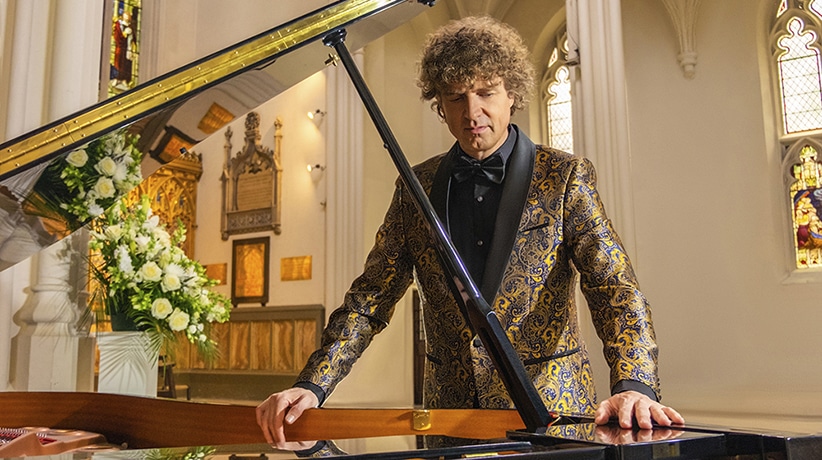Fitting for the solemnity of Christ the King, the eschatological dimension of Advent and for everyday Christian living, award-winning Christian composer and pianist Ian Mulder‘s new symphony, “Crowns of Christ,” is a stunning and truly crowning achievement. In addition to its being an exquisite musical feat, the symphony also offers a feast of faith for the ears and hearts of Christians.
Each piece in the 12-piece symphony is a unique variation on the traditional favorite hymn “Crown Him with Many Crowns,” written by famous British-Canadian hymnodist Matthew Bridges in 1851, just a few years after his conversion to Catholicism. Each work focuses on a different “crown” of Christ’s life and ministry and exemplifies Mulder’s genius. One of Mulder’s goals in composition, which is also one of the key features in the appeal of his music, is to move the audience as a film score might. With that approach as a guide, “Crowns of Christ” can serve as something of a soundtrack to the entirety of Christ’s life.
While listening to this symphony, it is possible to develop one’s own relationship with Christ and reflect on how his work of salvation manifests itself to us. After listening to and considering each piece — while contemplating each title of Christ connected to it — I am pleased to share how the work has resonated in my own faith life.
The opening piece, “King of Kings,” which begins the symphony appropriately with great regal character and verve, is a fitting introduction to the entirety of the composition. Not only is the listener solidly introduced to the tune that binds the symphony together, but one can imagine an opening scene that sums up the entirety of who Christ is and what he is about. One truly is introduced in orchestral fashion to Christ the King: the babe, as promised to Mary, of whose “kingdom there will be no end” (Lk 1:33) and the heavenly Lamb of God — slain, victorious, and crowned — who is “King of kings” on whose side are the “called, chosen, and faithful” (Rv 17:14).
Followed by the softer, more tranquil “Prince of Peace,” the listener can envision the beauty of Bethlehem and the newborn king, long hoped for and prophesied to come by Isaiah with the same title as the piece (cf. Is 9:6). The composition evokes peace of soul as one contemplates the peace of Christ that St. Paul says we must let control our hearts (Col 3:15). This is the same babe whom the angels heralded as the one who brings peace to all men (Lk 2:14), worshipped by kings (Mt 2:11), and who — later, as risen Savior — both gave and promised peace (Jn 14:27).
“Lord of Lords,” a very British, very baroque interpretation of the theme, offers an image of a figure emerging amid increasing greatness. Given that, and also with a processional feel, the image comes to mind of Christ’s baptism, in which he emerges from obscurity to claim publicly his messianic mission, in which he is identified as the Lord of heaven and earth by the sound of his heavenly Father’s voice (see Mk 1:11). Here the world meets the Lord Jesus, whom “every tongue should confess … is Lord, to the glory of God the Father” (Phil 2:10-11).
The gentle, non-obtrusive “Bread of Life” makes the case for Christ’s teaching, indeed getting straight to its heart with the focus on Eucharist, which, in turn, lies at the very heart of the Church’s life and mission. “I am the bread of life,” Christ said. “He who comes to me shall never hunger, and he who believes in me shall never thirst” (Jn 6:35). This self-gift of Christ is represented in the orchestra’s simplicity. Hidden under the simple forms of bread and wine, Christ comes to us and offers us eternal life (cf. Jn 6:54).
The uniqueness of Christ and his mission is made present in “Son of Man” by the solitary piccolo trumpet that leads the piece. Coming before “Lord of Love” — in which Christ’s passion, death and resurrection can be inferred — “Son of Man” evokes the dramatic close of Christ’s public life, particularly with his entry into Jerusalem and his proclamation as king. There is also a persistence and eagerness to the piece, characteristics of Christ’s own service. The romantic and emotional “Lord of Love” offers an opportunity to dwell freshly on the events of Holy Week and the greatest act of love the world has ever seen. Starting soft and gentle, becoming more passionate as the piece advances, one can imagine the increasing intensity of Christ’s passion — in which we see the fathomless depth of “no greater love” (Jn 15:13).
At the center of the symphony is its longest piece, “Lamb of God,” which is composed with starkness, freshness and simplicity, particularly in its opening and closing. One cannot help but feel something unique when listening to this. Of course, the lamb enthroned on high in Revelation, crowned in victory, comes to mind. But so, too, does the lamb once slain who lives forever — “For our paschal lamb, Christ, has been sacrificed” (1 Cor 5:7). It is the Risen Christ who emerges from the tomb, transforms the world, and makes all things new.
This continues with “Risen Lord,” in which the crown of the Paschal Mystery is put before us still, but in a bolder, more dramatic approach. Just like Christ’s invitation to Thomas to touch the wounds that made us whole, in which the Risen Christ challenges us to have faith in the incredible. Indeed, this most incredible thing lies at the heart of Christian belief. But as St. Paul said, “if Christ has not been raised, then empty [too] is our preaching; empty, too, your faith” (1 Cor 15:14).
Christ’s closing words on earth and his mandate to the apostles — which unites his mission on earth and in heaven — take place just before his return to heaven. This is tied to “Lord of Heaven,” a piece ethereal and celestial in character. This composition gives a sense of journey, proving a backdrop for meditating on the Lord’s ascension to heaven and anticipating the moment in which his heavenly Father crowns him as King of the universe. One envisions the return to glory of the all-obedient one, who calls us to obedience.
Next comes “Son of God,” with its sense of movement and building anticipation, culminating in great solemnity. One cannot help but think of Christ returning to his Father, presenting to him the Son’s obedience in mission, his oblation of love. The piece lends itself to imagining the divine Son being ushered into the holy of holies, accompanied by the angels and followed by the saints of old, bringing to the Father all that he gave away on earth, indeed his very self in the flesh. With dramatic timpani, one can imagine the Son embraced by the Father, then seated in majesty — “exalted at the right hand of God” (Acts 2:33) — where he pleads for us in glory.
That is until he comes again. “Immanuel,” with its brevity and immanence, offers an interlude between “Son of God” and the finale “Light of the World.” Immanuel — God with us — not only harkens to the incarnation but also to the second coming: “God himself will be with them [as their God]” (Rv 21:3). When Christ comes again, with the grandeur and magnificence evoked in this final piece, he will judge the living and dead. Then we will know, in the fullest sense, Christ’s words: “For there is nothing hidden that will not become visible, and nothing secret that will not be known and come to light” (Lk 8:17). The author of Revelation speaks of this day in describing the New Jerusalem — itself perhaps a fitting passage tying together various themes of the entire symphony for its conclusion — with the sense that this piece beautifully transmits. There, the Lamb — crowned with many crowns — is the light that dispels all darkness (cf. Rv 21:23). We pray we are ready for that day.
Mulder’s “Crowns of Christ” is available on his newly released album “Love Divine 7,” recorded with the Royal Philharmonic Orchestra.
Michael R. Heinlein is editor of SimplyCatholic.com and author of a forthcoming biography of Cardinal Francis E. George, OMI.





